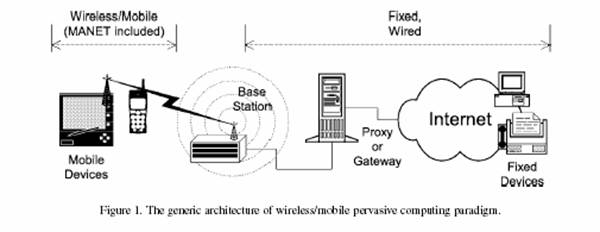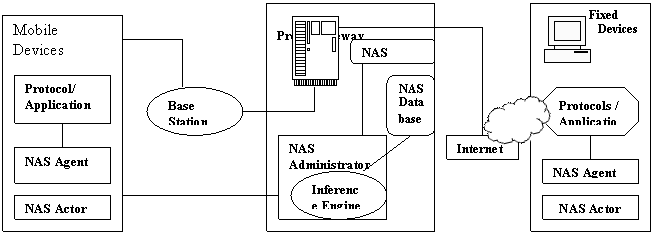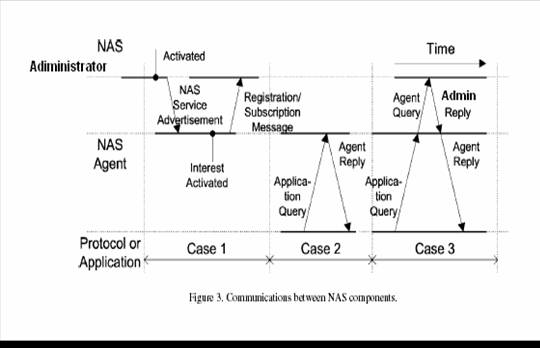paper no: net1
last update: 27/05/08
NETWORK AWARENESS SERVICE
(wireless/mobile pervasive computing implemenation of a piecewise approach)
1. INTRODUCTION:
1.1 PERVASIVE COMPUTING
“ Anytime/Anywhere-->Any Device --> Any Network --> Any Data ”
Pervasive computing can be defined as access to information and software applications anytime and anywhere. This form of computing is highly dynamic and disaggregated. It enables network devices to be aware of their surroundings and peers, and to be capable of providing services to, and using services from, peers.Pervasive computing increasingly involves mobile devices with wireless facilities. Only wireless/mobile devices with wireless Network Interface Cards (NIC) or wireless modems taking part in computing tasks with other fixed and wired devices are considered here.The generic architecture of the pervasive computing paradigm can be described from the figure shown below.

The figure shows two domains:
• The wireless/mobile domain connects to
• The fixed wired domain via a wireless link.
A dedicated proxy or gateway as a service point is generally used to enhance the performance of inter-domain communications.
There are three reasons for this:
- The amount of data transferred to mobile devices must be filtered because of the orders of magnitude difference in bandwidth between the wired and wireless connections.
- The wireless connection quality is too poor to sustain a client-server application.
- Portable computing devices have display and processing limitations that must be addressed by the proxy before sending the filtered response to the mobile devices.
1.2 NETWORK AWARENESS SERVICE (NAS)
To realize pervasive computing, network devices and applications need to be aware of network environments. Network Awareness is a key element in pervasive computing. Network awareness is the property of having knowledge about the current status of underlying network resources, but an important consideration should be that the cost of acquiring network awareness does not exceed its utility: if not obtained efficiently, it could decrease performance. Mobile devices are presented with some major challenges: network topology can change constantly, bandwidth can be limited, latency can be high and communication links can be down because of natural causes or power conservation. Hence, mobile agents need to be aware of relevant changes in the availability of network resources (awareness), and need to react accordingly to guarantee successful performance of their tasks (agility).
2. PIECEWISE DESIGN FOR NETWORK AWARENESS:
Our approach to network awareness takes advantage of the fact that the generic architecture (shown in fig: 1) consists of a wired and a wireless part. Thus all issues related to awareness about an end-to-end communication link are considered piecewise, i.e., the wired and wireless parts are considered separately and the end-to-end characteristics are derived by combining the piecewise characteristics, whereas a unitary approach considers the entire communication path for the awareness purposes as a single piece. We expect the piecewise approach to enhance the performance of pervasive computing by saving the wireless bandwidth and battery energy and by reducing the inter-domain monitoring traffic for network awareness that is transmitted through wireless links. Moreover, piecewise network awareness, as a service, should be ubiquitously available in a pervasive computing environment.The NAS framework is designed to be scalable to both high-and low-power-computing platforms. Network awareness in this framework is piecewise and scalable to fit into the scenario of the pervasive computing paradigm with mobile devices of very low capabilities.
2.1 PIECEWISE FRAMEWORK ARCHITECTURE:
The framework advertises the network awareness service. It acquires, measures, integrates, and distributes the parameters that reflect the current characteristics of the heterogeneous data networks. Network applications, protocols, and services that wish to use the NAS can acquire those parameters and apply them to leverage different pervasive computing tasks. The framework is transparent to network applications, services and protocols that do not explicitly use the NAS. It appears to them just as another network application.
T he architecture of the NAS framework consists of four main components:
- The NAS Actor
- The NAS Database
- The NAS Administrator
- The NAS Agent.
Each piece realizes different functionality.
 Figure2. Piecewise NAS Framework
Figure2. Piecewise NAS Framework
2.1.1 NAS ACTOR
: A NAS actor implements different network-awareness techniques, such as methods to obtain wireless-channel parameters or to measure the available bandwidth. It is an optional component at the mobile device, subject to resource limitations and the framework's scalability. Any network device with active NAS actors can be a service provider.
2.1.2 NAS DATABASE:
The NAS database is a collection of data that reflect the current characteristics of the networks. Data are acquired from NAS actors at the proxy or gateway, collected from the NAS agents at mobile devices, integrated via an inference engine, and distributed by the NAS administrator. Some data may be selectively acquired from other service agents, such as SNMP agents and ICMP service. The database has a hierarchical architecture for simplicity, extensibility, and compatibility.
2.1.3 NAS ADMINISTRATOR :
The NAS administrator manages the NAS database. It collects, integrates, and distributes the NAS data. The administrator may communicate with other service agents, such as an SNMP agent or SNMP administrator, to acquire additional information that the existing NAS actors do not provide and its inference engine integrates the data collected. Also, the administrator is responsible for answering queries from the NAS agent. Once the NAS administrator is activated at the proxy or gateway, it advertises NAS services through a well-known multicast channel defined in the NAS implementation (case 1 in figure 3). The advertisement includes the service name and description. The administrator also listens to the service advertisement and service subscription messages from NAS agents.
2.1.4 NAS AGENT:
The NAS agent acts as an interface for the network devices which are interested in utilizing the services provided by the NAS framework. Based on the local device computing capabilities, the NAS agent will activate all the local NAS actors. Otherwise, the service actors are activated at the proxy or gateway. The agent informs the NAS administrator of the services provided by the active local actors. This is done through a well-known multicast channel.A protocol or application may approach the agent for services announced by the NAS administrator. If the information requested in the query can be obtained from local active NAS actors, the NAS agent will reply immediately otherwise, the NAS agent will redirect the query to the NAS administrator to perform the awareness task and return the reply.

For Further more download pdf...
|